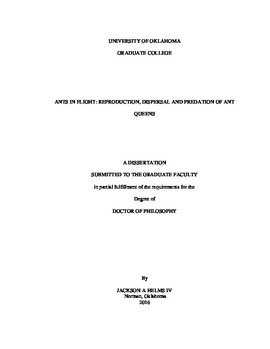| dc.description.abstract | Flying animals, especially insects, are a prominent feature of most terrestrial environments and make up a majority of the world’s known species. The biomechanical demands of flight shape the biology of flying insects at all levels, including their physiology, life history, and interactions with other organisms. Many social insects live in colonies consisting primarily of wingless workers, where the ability to fly is restricted to specialized castes. In most ant species, reproductive queens have wings and fly to leave their nest, mate, and found colonies. Here I investigate the role of flight in ant biology, starting with first principles of flight mechanics and physiology, building to the evolution of different life histories, and finishing with the value of queens as prey for aerial predators, the distribution of ants in the atmosphere, and the spread of invasive species across landscapes.
In Chapter 1 I investigate a potential tradeoff (the Found or Fly hypothesis) that ant queens experience between flight and reproduction. I do this by examining variation in flight morphology within a single species, the tropical cavity-nesting ant, Azteca instabilis. Queens of this species vary substantially in abdomen weight throughout the year. Heavier abdomens contain larger nutrient reserves that help young queens rear worker offspring and found new colonies. But they also incur a cost in flight morphology, by reducing flight muscle ratios and increasing wing loading and the drag experienced during flight.
Chapter 2 asks whether the Found or Fly tradeoff applies at an evolutionary level among species. By comparing queens of 21 species from a community in Panama, I find that flight ability is tied to reproductive strategy. Claustral species—those which fuel colony founding entirely through their abdominal nutrient reserves—have heavier abdomens and lower flight muscle ratios. Claustral species avoid adverse effects on wing loading, however, by evolving larger wings. Several claustral species have flight muscle ratios at or below the theoretical limits for insect flight, and may have adaptations for load-carrying. Queens that have access to external sources of nutrition during colony founding, on the other hand, such as social parasites, fungus-gardeners, and those that hunt their own prey, have lighter abdomens and high flight muscle ratios.
Chapter 3 applies these insights to alternate queen castes within the same species, and attempts to relate flight morphology to performance through a live flight experiment. I examine the flight morphology of two fire ant species that co-occur along the U.S. Gulf Coast—the invasive Red Imported Fire Ant (Solenopsis invicta) and the native Tropical Fire Ant (S. geminata). In both species, colonies produce both heavy claustral queens and light parasitic queens. Among claustral S. invicta queens, individuals with lighter abdomens can fly for longer periods of time. When comparing queen types, claustral queens of both species have heavier abdomens, lower flight muscle ratios, higher wing loading, and higher drag than their parasitic counterparts. In S. geminata, claustral queens also have larger wings, offsetting some of the adverse wing loading effects and mirroring interspecific patterns.
The next two chapters address what happens to ant queens once they enter the atmosphere on their mating flights. I attach altitude logging devices to Purple Martins (Progne subis), a bird that preys on insects it captures during flight, and monitor the prey they deliver to their young. In so doing I discover (Chapter 4) that Purple Martins in Oklahoma feed primarily on invasive Red Imported Fire Ant queens, and double their foraging efficiency by doing so. I calculate that across the southern USA, Purple Martins probably eat billions of fire ant queens each year. I also measure the flight altitudes of ants and other insects (Chapter 5), and find that heavier ants fly at lower altitudes in the atmosphere, consistent with the Found or Fly tradeoff.
Finally, in Chapter 6 I develop a computer model to simulate the dispersal and reproduction of Red Imported Fire Ants introduced to a novel environment. In the simulations, hypothetical fire ant populations that invest more heavily in parasitic queens, and less in claustral queens, experience larger average colony sizes, higher habitat occupancy, and slower range expansion. When investigating the optimal investment by a reproductive colony, I find that colonies at an expanding range edge benefit more by investing almost entirely in claustral daughter queens, while those in the interior of a range benefit by investing more heavily in parasitic daughters. The two divergent selection regimes may play a role in the evolution of alternate reproductive strategies in ants. | en_US |
